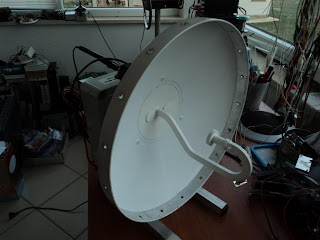Not so many simple transverters for 6cm band seen up to now. So here
is one, really simple and working, with minimum parts required and poor
guy like me did find all the parts within the pile of microwave "LEGO
bricks".
The architecture is traditional and straightforward, no
bells and whistles in this design. The core of the transverter is the
mixer. Simple as it can be, SKY-60 double balanced mixer working up to
6GHz with affordable price, new through the e-bay purchase. Drive on the
IF port 0dBm @ 432MHz, +7dBm @ 5328MHz for the LO port. On the output
RF port we have LO, LO+432MHz and LO-432MHz signal present. To get rid
of the unwanted signals the mixer is followed by the filter. Here we can
use many types of filters but the pipe cap was a simple and cheap
solution, can be tuned easily even with no special measuring equipment.
Tune to peak method will give good results. Of course the frequency is
5760MHz. This filter will be used both , for RX and TX operation. PIN
diodes, RF switch, relay, resistor splitter or Wilkinson divider. Well, the Wilkinson divider was appropriate and simple
enough for this approach. More over, no switching required for RX/TX
operation. I made mine from the old 1.8GHz cellular equipment easily
cutting out the peace of the PCB with the printed divider. Simple
calculation, sharp x-act knife and the divider legs were modified to L/4 @ 5.760MHz.
This way I end up with two ports, one for the RX and the other for the
TX side of the transverter. For the RX front end i choose not the best,
but cheap and simple MMIC block with the MGA-86563 declared to work up
to 6GHz with not so bad performance. The MMIC was biased for the maximum
gain with 8V power supply. On the transmitting side there is also a
MMIC block, simple Sirenza SNA-586 good up to 6GHz biased for the
maximum gain with 8V power supply.
So this is it, a simple transverter,
of course with the limited performance but good for the quick qso with
the neighbor station or somebody on the hill within the line of sight.
To operate this transverter we need some kind of local oscillator and a
simple electronics handling the power and antenna switching. Crystal
oscillator with the chain of multipliers can give us maybe better phase
noise but better stability and more flexibility in choosing the IF
insure the synthesizer built fir microwave frequencies. I choose the
VK3XDK Si-4133 synthesizer version with the 16 programmable frequencies.
The synthesizer is locked to high quality 10MHz double oven oscillator
granting excellent stability and lower phase noise comparing to the
cheap 10MHz canned oscillators. I prefer to use the 70cm IF so the LO
was programmed to 1776MHz. The 13dBm output was attenuated with the 7db
attenuator to safely drive the 3x multiplier box producing some 15dBm of
the signal @ 5328MHz. Again 7db attenuator between the multiplier and
mixer to bring the signal to the required mixer level. At the same time
the mixer was very happy to "see" the 50 ohms impedance at any port. For
this experiment i choose the IF 432MHz, but much better will be 434 or higher. Not more than 0dBm is required on the mixer IF port, so the 27dBm (500mW) signal from the FT-817d was
reduced with the 26db attenuator at the sequencer board. Sequencer is
also switching the power for the MMICs in the transverter as well as the
power for the coaxial relay at the output. RF sensing and PTT ports
insuring high protection. If the coaxial relay or RF electronic switch is not available
we can use two separate antennas for the RX and TX. With this
arrangement the setup is ready for the smoke test and initial qso
testing. The output power is low, not reaching not even 1mW and the
conversion gain is also poor just a few db so some extra amplification
is required for serious work.
Good LNA will lower the noise figure and
improve the conversion gain and on the other side a few MMICs on the TX
side will give us pleasure to work some distant stations. Just for the
test I add another SNA-586 on the TX side bringing the signal up to the
3dBm. Not much, but at the same time I add another pipe cap filter
between the MMIC blocks to reach the cleaner signal at the output.
Result can be seen at the video. The same approach can be used to build
the transverter for the other microwave bands, so no excuse for the low
activity at the microwave bands.
So "Use them or lose them"


.JPG)
.JPG)




.JPG)